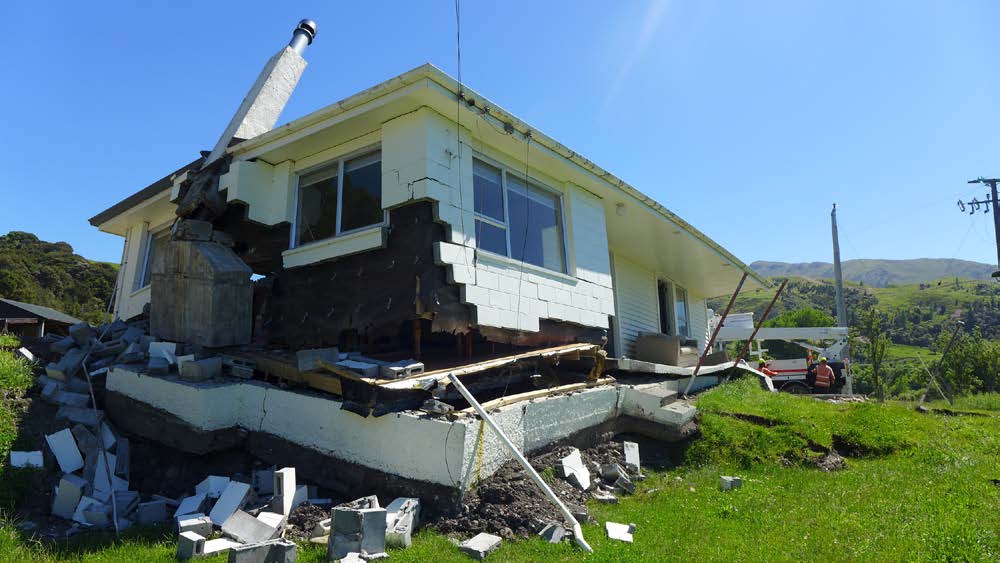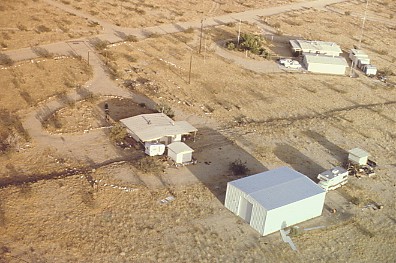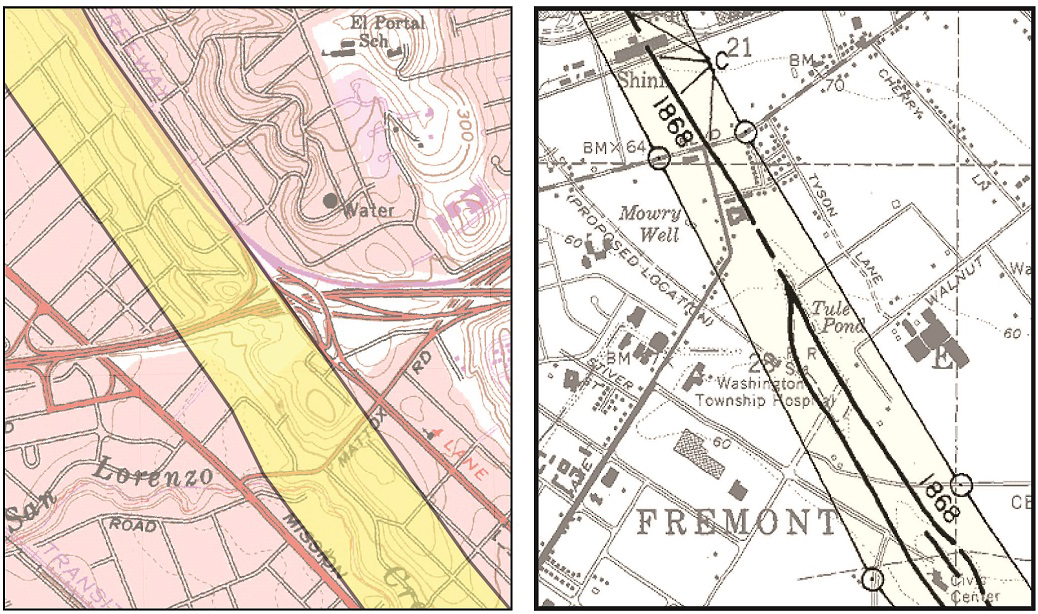 Cottage destroyed by surface fault rupture on the Kekerengu Fault during the magnitude 7.8 2016 Kaikoura earthquake in New Zealand. Approximately 10 meters of right-lateral fault displacement occurred under this house, tearing it from its foundation. Photo credit: VML 190573, Julian Thomson, GNS Science / Earthquake Commission
Cottage destroyed by surface fault rupture on the Kekerengu Fault during the magnitude 7.8 2016 Kaikoura earthquake in New Zealand. Approximately 10 meters of right-lateral fault displacement occurred under this house, tearing it from its foundation. Photo credit: VML 190573, Julian Thomson, GNS Science / Earthquake Commission
Alquist-Priolo earthquake fault zones are regulatory zones surrounding the surface traces of active
faults in California. (A trace is a line on the earth's surface defining a fault.) Wherever an active fault exists, if it has the potential for surface rupture, a structure for human occupancy cannot be placed over the fault and must be a minimum distance from the fault (generally fifty feet).
Earthquake fault zones were conceived in the
Alquist-Priolo Earthquake Fault Zoning Act (Alquist-Priolo Act). The intent of the Alquist-Priolo Act is to reduce losses from surface fault rupture. California created this law following the destructive 1971 San Fernando earthquake (magnitude 6.6), which was associated with extensive surface fault ruptures that damaged numerous structures.
An
active fault, for the purposes of the Alquist-Priolo Act, is one that has ruptured in the last 11,000 years.
Surface Fault Rupture Explained

Surface fault rupture occurs when movement on a fault breaks through to the earth's surface. Surface ruptures associated with the 1992 Landers Earthquake, in San Bernardino County, extended for fifty miles with displacements ranging from one inch to twenty feet.
Not all earthquakes result in surface rupture. The Loma Prieta Earthquake of 1989 caused major damage in the San Francisco Bay Area but the movement deep in the earth did not break through to the surface.
Surface rupture almost always follows pre-existing faults. It may occur suddenly during an earthquake or slowly in the form of fault creep. Fault creep is slow rupture of the earth's crust. Examples of creep are well known along the Hayward Fault where it crosses highly developed areas in Contra Costa and Alameda Counties. Although the Hayward Fault ruptured suddenly in the 1868 earthquake, it also exhibits slow surface creep which offsets and deforms curbs, streets, buildings, and other structures that lie on top of the fault.
Other earthquake-related hazards
The Alquist-Priolo Act only addresses the hazard of surface fault rupture and is not directed toward other earthquake hazards; however, the
Seismic Hazards Mapping Act addresses other earthquake hazards, including liquefaction, landslides, amplified ground shaking, and inundation by tsunami or seiche.
What Earthquake Fault Zones Mean To You
Learn how and why the California Geological Survey maps areas susceptible to earthquake hazards and helps mitigate these risks by providing helpful scientific information.
You should know your rights and risks if you plan to buy, sell, develop, or remodel property affected by an earthquake fault zone. There are disclosure and investigative requirements that must be considered for real estate transactions and development projects, summarized below.
Real Estate Disclosure Requirements
In real estate transactions, the seller must disclose to prospective buyers when an earthquake fault zone affects the property for sale.
The Natural Hazards Disclosure Act, under
Section 1103 of the California Civil Code, requires that sellers of real property and their agents provide prospective buyers with a "Natural Hazard Disclosure Statement." If the property being sold intersects an Alquist-Priolo earthquake fault zone, that fact must be disclosed to a potential buyer before the sales process is complete. The real estate agent is legally bound to present this information to the buyer. When no realtor is involved, the seller must inform the buyer directly.
California law specifies two ways in which the disclosure can be made:
In addition to earthquake fault zones, information shown on
Official Maps of Seismic Hazard Zones and other state and federal maps of natural hazards also must be disclosed.
Development Project Requirements
Local agencies must regulate development projects within earthquake fault zones. Before they can permit a new project, cities and counties require a geologic investigation to demonstrate that proposed buildings will not be constructed on active faults. Projects include all land divisions and most structures for human occupancy. The investigation and written report must be prepared by a geologist licensed by the State of California. Local agencies can be more restrictive than state law requires, so check with your local permitting agency for specific requirements.
How to Determine if a Property is Affected by an Earthquake Fault Zone
The Alquist-Priolo Act requires the State Geologist (CGS) to establish earthquake fault zones around the surface traces of active faults and to issue appropriate maps. CGS has identified earthquake fault zones in thirty-seven California counties, affecting more than one hundred cities. Here are a few ways for you to determine if a property is affected by an earthquake fault zone:
-
The
California Earthquake Hazards Zone Application (EQ Zapp). It's an interactive map that shows earthquake fault zones and seismic hazard zones in relation to any parcel in California.
-
CGS Official Maps of Earthquake Fault Zones by quadrangle. CGS has created more than 500 of these maps statewide:
-
You can download the quadrangles in Portable Document Format (PDF) from the
Regulatory Maps and Reports section of the CGS Information Warehouse web site.
-
As another option, paper copies of quadrangles are available for reference through your local municipality's planning department. The California Geological Survey distributes the maps to all affected cities, counties, and state agencies for their use in planning and controlling new or renewed construction. Counties are required to post notices at the offices of the assessor, recorder, and planning agency that advise the public of the availability and location of earthquake fault zones affecting that county (Public Resources Code 2621).
-
Paper quadrangles are also available for reference at the
CGS Library, at
several other libraries throughout the state, and at
our regional offices in Los Angeles and San Mateo.
How to interpret Official Maps of Earthquake Fault Zones
The California Geological Survey periodically issues official maps of earthquake fault zones, in compliance with the Alquist-Priolo Earthquake Fault Zoning Act. Two examples of earthquake fault zone maps are shown in the figure below. The newer map on the left shows an earthquake fault zone as a semi-transparent yellow polygon. The older map on the right shows an earthquake fault zone as semi-parallel lines connected to small circles where the lines change direction. Also on the older map, faults are depicted as thicker black lines running through the center of the zone. On newer digital maps, faults are not visible by default, but they can be made visible using the layer control feature integrated into each map.

In both examples, the zones are long and narrow. This is typical of earthquake fault zones, which can be miles long but average about one-quarter mile wide. Because they are relatively narrow, they will not exist throughout all of an affected city or county.
How to be certain a map is an Official Map of Earthquake Fault Zones
The following text appears on all official maps of Alquist-Priolo earthquake fault zones issued after June 1, 1995:
STATE OF CALIFORNIA
EARTHQUAKE FAULT ZONES
Delineated in compliance with
Chapter 7.5, Division 2 of the California Public Resources Code
(Alquist-Priolo Earthquake Fault Zoning Act)
[NAME] QUADRANGLE
OFFICIAL MAP/REVISED OFFICIAL MAP
Effective: [Date]
[Signature of State Geologist releasing map]
STATE GEOLOGIST
NOTE: Alquist-Priolo earthquake fault zones were once known as "Special Studies Zones." Maps issued prior to June 1, 1995 will have "SPECIAL STUDIES ZONES" in the title block instead of "EARTHQUAKE FAULT ZONES."
For More Information
If you believe a property is affected by an earthquake fault zone, here are ways you can learn more about the potential of surface rupture on the property:
-
Ask the property owner or real estate agent to see any geologic report prepared for the site.
-
Check the files of local government for consulting reports for nearby sites.
-
Research reports and data on active faults at technical libraries at the California Geological Survey, U.S. Geological Survey, and universities. Most fault investigations required by the Alquist-Priolo Act are on file with the California Geological Survey.
-
Hire a licensed geologist to provide a preliminary assessment of the fault-rupture hazard for a specific site.
-
Consult
Special Publication 42, Earthquake Fault Zones - A Guide for Government Agencies, Property Owners / Developers, and Geoscience Practitioners for Assessing Fault Rupture Hazards in California. Special Publication 42 contains technical guidelines for evaluating surface fault rupture hazards and for reviewing geologic reports. Special Publication 42 is published by the California Geological Survey and is revised when new earthquake fault zone maps are issued or when changes are made to the Alquist-Priolo Act.
Submit Your Quaternary Fault Mapping Data to Our Upload Portal
The California Geological Survey maintains a geodatabase of Quaternary faults in California, which is updated as new mapping becomes available. We welcome submissions of Quaternary fault mapping from the user community to be considered for inclusion in the Quaternary fault database. If you have mapping you would like to have considered, please feel free to upload it, along with supporting documentation, at the Quaternary Faults Data Upload Portal.
Web page by:
California Geological Survey - Seismic Hazards Program
